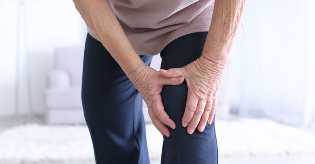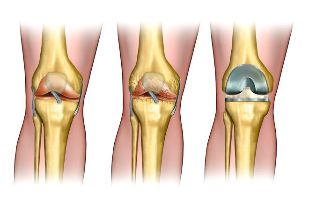Osteoarthritis of the knee (gonarthrosis) is the defeat of the knee predominantly non-inflammatory in nature which causes wear of the cartilage layer of the knee and by the time the destruction of the cartilage, the deformation of the knee and limit mobility. Therefore, it is important to be able to recognize the disease and know how and what it was about.

Osteoarthritis of the knee (it is still called the gonartrosiom – from the ancient Greek "goni" – knee) is a progressive degenerative degenerative defeat the cartilages that cover the articular surface, which leads to the rupture of his work and the pain.
The causes of osteoarthritis of the knee
Osteoarthritis osteoarthritis is divided into primary (originating from yourself), and secondary, which occurs because of other diseases of the knee.
Primary
Primary osteoarthritis (genuinny) is osteoarthritis begins without obvious reason, and that strikes do not change the articular cartilage in many joints is interrupted. It is observed more frequently in people over the age of 40 years. Also shown that women more often than men suffer from osteoarthritis of the knees and of the joints of the wrists.
Because it occurs primary osteoarthritis, up to the end not clarified, but, very probably, to him bring disorders of the metabolism. This causes a change of the biochemical reactions that occur in the cartilage tissue. By the time he destroyed, degenerative, and lumps of salt. The surface of the knee changes with the structure of the cartilage, resulting in knee, the fluid accumulates and the cysts Becker.
Secondary
It is the result of disease or damage to the joints, their clinical manifestations are not different from the primary. Develops in virtually all of the joints.
Secondary osteoarthritis occurs for the following reasons:
- the inflammatory process, immune or infectious origin;
- high-grade dysplasia or traumatic lesions of the meniscus of the knee or (miniscope);
- intra-articular fractures of the bones that form the knee joint;
- rheumatic arthritis;
- cancer of the bones;
- ankylose spondylitis;
- osteoarthritis, resulting from Paget's disease.
The symptoms

The symptoms of osteoarthritis can be attributed to the following:
- the pain in feet, knees, hip joints, back;
- joint stiffness, stiffness and creaking of the joints;
- the pain after sleeping or long stay in the same position;
- swelling of the joints;
- pain when the weather changes;
- joint pain after load;
- the injury – fractures, sprains, and also damage to the meniscus;
- high loads;
- overweight and obesity;
- weak ligaments – messy ligaments;
- violation of metabolic processes in the body;
- stress.
Deformation of the joint
Deformation of the joint – this change of form the joint, called the offset end of the mating bones in the case of a dislocation, the joint development of a pathological tissue growths. Often the deformation are the joints of the hands and feet, legs.
The deformation of the joints is usually the result of complex rates of irregularities in periarticular, bone, or cartilage tissues, where they accumulate atypical in this localization and the concentration of the substance.
The consequence of the deformation of the joints often becomes the remodelling of joints, bone growth, subluxations in the joints and lesions of the muscle and the ligament of the neck of the foot of the machine.
With respect to this concomitant basic gonartrosie applicable symptomatic treatment, however, an approach aimed at the resolution of the disease in general, demonstrates greater efficacy and prevent relapse.
The diagnosis of deformation of the joints occurs regardless of the staging of general diagnosis. Located at the base of a further examination and general results. An objective study of the joints allows you to determine their configuration, swelling, pain during sensitivity and movements, the volume of active and passive joint movements and changes of the skin and subcutaneous tissue of the joints.
Limitation of joint mobility
Distinguish different degrees of restriction of the mobility: from mild, barely perceptible violate the usual amount of motion, up to total loss of mobility.
According to the degree of limitation of joint mobility are distinguished:
- Ankylosis – complete immobility in a patient with the joint.
- Stiffness – only saved a small amount of movements. For example, small rocking movement. When using the stiffness should be differentiated from ankylosis.
- Contracture – restriction of the mobility is strong and significant, but, however, there remains a certain opening of movement in the joints. Diagnose the amount of movement is possible with a simple protractor.

The degree of osteoarthritis of the knee
The first. In this case, the disease is characterized by mild pain when performing active movements. You can collect the synovial fluid in the joint cavity, which leads to the formation of cysts Baker. Pain occur during movement, but once you play in a state of rest. The damaged cartilage, but the external deformation of the joint invisible.
The second. Occurs a narrowing of the joint space, the cartilage is damaged to a large extent. In the photo, received in the course of a radiograph, you notice an excessive growth of the bones. Acute pain is accompanied by any movement, which participates in the articulation of the knee. At rest the unpleasant feeling pass, but then appear again. The pain adds crunch when the extensor movements.
The third. Places cartilage becomes thin, will form the foreign particles to the bone. On the x-ray clearly visible, a large number of osteophytes – deposits of salts in the joint cavity. In addition, there can be detected the body loose.
The possible complications and consequences for osteoarthritis of the knee
Osteoarthritis of the knee is a degenerative disease, which with time progresses. Joint pain and stiffness become so severe that the patient is not able to cope with daily activities. Some people lose the ability to work, when the osteoarthritis it is a phase, that your doctor recommends only the operation of replacement of the joints.
If you ignore the symptoms of the illness and timely treatment, the risk of complications is quite high.
The possible implications for running osteoarthritis refer to:
- the critical deformation of the joint, its complete destruction;
- global limited mobility;
- aspect of the intervertebral hernias;
- the reduction in the quality of life, the loss of integrity.
What kind of doctor takes care?
This can be the doctor, the surgeon, and orthopedist. If it is necessary to appoint the council rheumatologist. Doctor rheumatologist examine You, establish an accurate diagnosis, to determine which joints amazed. Prescribe laboratory and instrumental methods of diagnosis.
Only with the help of the comprehensive examination, the specialist will be able to answer the basic question: at what stage gonartrosie the patient, and type of treatment needed.
In the presence of concomitant disorders of the spine requires consultation neurologist and vertebrologist. These professional has prescribed the restoration treatment, during which persists the pain because of violations of nerve fibers in the intervertebral discs.

Diagnostics
The defeat of the joint, reminiscent of arthritis, occur in many other diseases, and ignorant people often err in determining the disease. Therefore, in no case, do not attempt to install the diagnosis alone.
The instrumental exams
X-ray diagnostics – the most popular and important method because of its simplicity, availability, and highly informative. The images are usually performed in two projections, side – to-side and direct, but if necessary they may use and the various details of the installation.
Ultrasound is considered to be very promising, which allows you to discover the liquid, to give an assessment of pathologies of the soft tissues, but also to view the cartilage and joint surfaces. The advantages of this method before x-ray has the ability to change the position of the sensor, and the lack of need for a strict positioning of the patient to obtain standard screenings.
Magnetic RESONANCE imaging and computer tomography provide a large amount of information, but also the possibility of obtaining a three-dimensional image of the area of interest.
Laboratory tests
When knee osteoarthritis pathological changes occur mainly in the articular cartilage and also subchondral bone, sheath synovial, other soft tissues of the joint. Since the possibility to explore directly these facilities are limited, the most important sources for the sampling of biological markers are blood, urine, and synovial fluid.
In the majority of cases in patients with osteoarthritis of the knee does not present changes in the analysis of blood and urine, with the exception of the cases of synovitis with a significant effusion, when you are experiencing an increase in the erythrocyte sedimentation rate, ipergammaglobulinemia, increased levels of the markers of acute-phase – c-reactive protein, fibrinogen, etc., in the study of the synovial fluid, no significant differences with respect to the media, do not touch.
In the last years, an intensive search for possible biological markers (BM) degradation and repair of joint tissues (especially cartilage and bone). BM reflect the dynamic changes, serve as predictors of the prognosis of knee osteoarthritis and indicators of efficiency pathogenetic treatment. The opening of new and more profound study of the famous BM will allow you to figure out if better to the mechanisms of the pathogenesis of osteoarthritis.
However, the main task of the use of biological markers of cartilage metabolism – evaluation of chondroprotective properties of drugs and the monitoring of treatment with drugs belonging to the group "change disease".
The treatment of osteoarthritis of the knee
The treatment of osteoarthritis, to use a euphemism, is not an easy task. Then, before beginning their difficult fight against this disease, be sure to find a good doctor, to be interviewed, and with him make a treatment plan.

Drugs
The most often administered drugs to relieve the inflammation and pain with osteoarthritis of the knee is the anti-inflammatory drugs non-steroidal nature. Drugs are effective in inflammatory processes, accompanied by synovitis. In addition, the above-mentioned drugs relieve the pain. However, they do not cure the disease itself.
During the intake of anti-inflammatory non-steroidal drugs must comply with all recommendations of the doctor, since these drugs an impressive number of side effects, especially after prolonged use.
Chondroprotectors is a class of drugs that restore osteo-cartilaginous tissue. During the intake of chondroprotectors should keep in mind that these drugs are more effective in the complete treatment of the disease.
Vasodilatatoria medicines are also assigned in the complex treatment of osteoarthritis. With the help of them is able to restore movement in the joint, and relieve the cramps in smaller vessels.
As an analgesic most commonly used are ointments or the poultices with the effect of heating. When you need a quick relief, can be given by intra-articular injection of corticosteroids hormones.
Surgery
Needling (minimally invasive surgery). This method is used for the diagnosis of the disease. A joint capsule cannulare, by removing part of the liquid. This allows to obtain material for examination, and to reduce the load on the capsule, if necessary, enter the corticosteroids directly into the site of inflammation.
Arthroscopy. Represents the introduction of a special device arthroscope through the micro-incisions in the skin. The method allows to closely examine the joint and remove the detached fragments of cartilage, by eliminating the causes of the inflammatory process and pain.
Periarticular osteotomy. The essence of the method is to deposit the bones with subsequent fixing them under another angle. The operation allows you to reduce the load on the joints and eliminate the pain for a long period of time. Despite its effectiveness, this type of surgery applies rarely – is too large the load on the body of a patient and long period of rehabilitation.
Arthroplasty. In those cases, when other treatments have not helped, and the disease is completely or almost completely destroyed the joints are replaced by prosthesis of plastic, metal, or ceramic.
Arthroplasty – heavy and costly operation that requires a long rehabilitation. Many patients in the space of a few months after surgery pain. However, this method is often the only alternative, immobility of the patient. The duration of the modern prosthesis reaches twenty years, and in all these years the patient can live a full life.

Recommended diet
The diet is necessary in the first place to control your weight. It is shown that osteoarthritis develops more commonly and more difficult tolerated as a once in people with excess weight, then:
- limit the consumption of alcohol, fatty foods, semi-finished products;
- check power mode;
- reduce the amount of salt;
- reduce the amount of sweets;
- eat more fruits and vegetables (giving preference seasonal).
Measures of prevention of osteoarthritis
The main activities to prevent the development of knee osteoarthritis are:
- the reduction of excess body weight;
- increase physical activity;
- a proper power supply;
- the respect of the principles of the HLS.
Maintain a healthy lifestyle to strengthen Your body, improve the state of cartilages, joints and bones. You need to give up the booze and the smoke. Spend a lot of time in the open air, immediately, less stress, and experience more of the good humor and positivity.
Osteoarthritis is a disease that does not heal completely, however, its development can stop you, if the time to pay attention to their health conditions and to proceed to the treatment. The therapy can reduce or even completely eliminate some of the symptoms, which will greatly facilitate the life of the sick person.
















